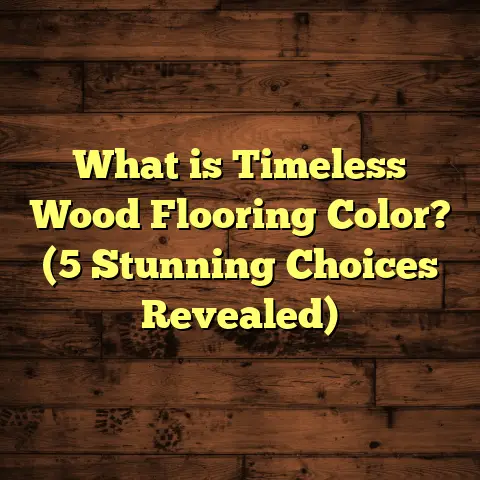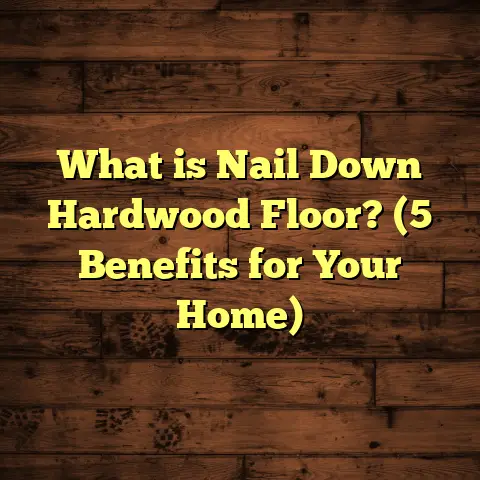What is a Hard Floor Surface? (5 Benefits for Homeowners)
What is a Hard Floor Surface?
I still remember the first time I installed a hard floor surface in my own home. The feel underfoot, the way light bounced off the polished surface, and how it transformed the entire room—everything about it was captivating. But what exactly is a hard floor surface? Simply put, a hard floor surface refers to any flooring material that is firm, durable, and typically made from natural or engineered materials like wood, stone, tile, or vinyl. Unlike carpet or soft rugs, these surfaces provide a solid foundation that stands up to wear and tear over time.
Over the years, as I’ve helped countless homeowners choose the right flooring for their needs, I’ve come to appreciate how versatile and valuable hard floors are. They’re not just about looks; they impact your day-to-day comfort, maintenance routines, and even health in ways many people don’t initially realize.
Defining Hard Floor Surfaces
Hard floor surfaces come in various forms but share a few common traits:
- Durability: They can withstand heavy foot traffic without significant damage.
- Low Porosity: Most hard floors resist stains and moisture better than soft floors.
- Maintenance: Easier to clean and maintain compared to carpets.
- Longevity: With proper care, these floors can last decades.
Here’s an overview of popular types of hard floors I often work with:
- Hardwood Flooring: Made from solid wood planks (oak, maple, walnut). Known for its classic beauty and ability to be refinished multiple times.
- Engineered Hardwood: Thin layers of real wood veneer over plywood or fiberboard. More stable in humid conditions.
- Laminate Flooring: Composite wood with photographic layer mimicking wood or stone. Affordable and scratch-resistant.
- Ceramic & Porcelain Tile: Fired clay tiles that are extremely durable and water-resistant.
- Natural Stone: Granite, marble, slate – heavy-duty, luxurious options that add unique texture.
- Luxury Vinyl Plank (LVP) & Tile (LVT): Synthetic materials designed to imitate natural flooring with excellent waterproof properties.
Each type has its own characteristics which affect installation methods, maintenance needs, durability, and cost.
Why Do Homeowners Prefer Hard Floor Surfaces? (5 Benefits)
Let me share some insights from my years in the business about why so many people choose hard floors for their homes. These benefits aren’t just theory—they come from real-world experiences working with hundreds of families.
1. Easy Maintenance and Cleaning
One of the biggest hassles with carpet or rugs is cleaning spills and stains. Hard floors usually just need a quick sweep and mop. For example, I once helped a family with three kids and two dogs switch from carpet to hardwood. Their relief was palpable when they realized muddy paw prints wiped away effortlessly.
Carpets tend to trap dust, dirt, and allergens deep within fibers—that’s a magnet for allergy sufferers. Data backs this up: According to the American Lung Association, homes with predominantly carpeted floors can have up to 6x more dust mite allergens than homes with hard floors.
Hard floors also dry quickly after spills—no chance of mold growth underneath like carpets might develop in damp conditions.
When you’re juggling busy schedules or have small children prone to messes, easy cleaning is a lifesaver. Just think about how many times you’ve had to scrub carpet stains or deal with lingering odors. With hard floors, that stress simply disappears.
2. Longevity That Saves Money
I often tell clients that while hard floors might have a higher upfront cost than carpet or rugs, they’re an investment. Hardwood floors can last 25-100 years if maintained well. Tile and stone often outlast that.
A study by the Hardwood Federation found that homeowners recoup about 70-80% of hardwood floor installation costs when selling their homes because buyers love durable flooring.
In one project I managed recently, a couple chose reclaimed hardwood flooring salvaged from an old barn. Not only did it add character but it also ensured a lifespan well beyond typical flooring choices. After a decade, their floor still looked great with just periodic refinishing.
Compare that to carpet which often needs replacing every 5-10 years due to wear or staining.
3. Aesthetic Appeal and Versatility
Hard floors offer timeless appeal. Whether you want rustic charm or sleek modern style, there’s a hard floor option that fits.
In my experience helping clients design their homes, I’ve seen how choosing the right flooring can tie an entire room together. I once worked with a client who selected herringbone-patterned oak flooring paired with minimalist white walls—simple but stunning.
You can pick from countless textures and finishes. Engineered hardwood mimics natural wood but is more stable in humid environments like basements. Ceramic tiles come in endless patterns from subway tiles to Moroccan-inspired mosaics.
Hard floors also reflect light better than carpeted surfaces, making rooms appear larger and airier.
Are you someone who loves changing decor seasonally? Hard floors provide a neutral canvas for rugs and furniture of all styles.
4. Improved Indoor Air Quality
This might surprise some people, but hard floor surfaces actually contribute to healthier indoor air quality. Unlike carpets that trap dust mites, pet dander, pollen, and other allergens deep within fibers, hard floors can be cleaned thoroughly and regularly.
A case study I was part of involved a family with severe asthma. After switching from wall-to-wall carpet to tile flooring throughout their home, they reported significant improvements in breathing and fewer asthma attacks within weeks.
According to the Environmental Protection Agency (EPA), indoor air pollution can be 2-5 times higher than outdoor air pollution—so minimizing allergen traps like carpets is crucial for health.
For families with allergy sufferers or those sensitive to dust, selecting hard flooring can make a tangible difference day-to-day.
5. Cost-Effective Over Time
While initial costs vary by material type and installation complexity, hard floors often save money over time due to:
- Lower maintenance costs compared to carpet cleaning or replacement
- Less frequent need for replacement
- Increased home resale value
- Greater durability reducing damage repair costs
Vinyl plank flooring offers a budget-friendly option mimicking wood or stone but costing less upfront and installing quickly. This makes it ideal for renovations on tight budgets without sacrificing appearance or durability.
When I plan flooring projects nowadays, I rely heavily on tools like FloorTally to get accurate cost estimates using local material prices and labor rates. It factors in waste percentages so I don’t order too much or too little material — this prevents unnecessary expenses.
Having clear cost estimates upfront helps me guide clients through budget decisions confidently without surprises later on.
Deep Dive Into Popular Hard Floor Types
To help you make an informed choice, let’s look closer at some common hard floor surfaces: what they are made of, pros and cons based on personal experience and industry data.
Hardwood Flooring
Hardwood is made from solid timber planks cut directly from trees like oak or maple.
Pros:
- Classic natural beauty
- Can be sanded/refinished multiple times
- Adds high resale value
- Durable against everyday wear
Cons:
- Sensitive to moisture (can warp in damp conditions)
- Higher upfront cost ($8-$15/sq ft installed)
- Requires regular maintenance (cleaning & refinishing)
In one project I handled for an older home renovation, we salvaged existing hardwood floors and refinished them instead of replacing — saving thousands while preserving character.
Janka Hardness Scale: Oak scores around 1290; hickory around 1820 — the harder the wood, the more resistant it is to dents/scratches.
Engineered Hardwood
Made with layers: real wood veneer on top of plywood or fiberboard core.
Pros:
- More stable than solid hardwood in humid areas
- Looks very similar to solid wood
- Usually less expensive than solid hardwood ($6-$12/sq ft installed)
Cons:
- Limited number of times it can be refinished (depending on veneer thickness)
- Still sensitive to water damage if installed improperly
In coastal climates where humidity varies greatly throughout the year, engineered hardwood avoids warping problems we sometimes see in solid hardwood floors.
Laminate Flooring
Laminate consists of fiberboard core topped with photographic image layer sealed by clear protective coating.
Pros:
- Affordable ($3-$8/sq ft installed)
- Scratch-resistant & durable
- Easy installation (click-lock systems)
- Wide variety of styles mimicking wood/stone
Cons:
- Less natural look compared to real wood/stone
- Can’t be refinished
- Water resistance varies by brand/type
I frequently recommend laminate for rental properties or high-traffic areas where budget is tight but durability matters.
Ceramic & Porcelain Tile
Tiles are made by firing clay at high temperatures; porcelain is denser and less porous than ceramic.
Pros:
- Extremely durable & water-resistant
- Great for kitchens/bathrooms
- Huge design options (colors, shapes, patterns)
Cons:
- Hard surface can be uncomfortable standing long periods
- Installation labor-intensive/costly ($5-$12/sq ft installed)
- Cold underfoot without radiant heating
One memorable kitchen remodel featured bold patterned encaustic tiles that became the focal point of the space — combining beauty and function perfectly.
Natural Stone Flooring
Includes granite, marble, slate, travertine — quarried directly from earth.
Pros:
- Luxurious appearance
- Durable & long-lasting (50+ years)
- Unique textures & colors no two slabs alike
Cons:
- Expensive ($7-$20/sq ft installed)
- Requires sealing & maintenance
- Heavy — sometimes requires reinforced subflooring
I helped a client install marble in their foyer — it added tremendous elegance but required careful upkeep including resealing every year.
Luxury Vinyl Plank & Tile (LVP/LVT)
Modern synthetic flooring designed to mimic wood or stone closely.
Pros:
- Waterproof options available
- Affordable ($2-$7/sq ft installed)
- Comfortable underfoot & quiet
- Easy DIY installation possible
Cons:
- Can fade over time if exposed to direct sunlight
- Lower resale value than hardwood/tile
I often suggest LVP for basements or rental units where moisture resistance and budget are top priorities.
Installation Insights From My Experience
Installation quality is just as important as material choice when it comes to longevity and performance of hard floors.
Here are some things I pay attention to during installation:
Subfloor Preparation Matters
Uneven or damaged subfloors cause squeaking or premature damage. For hardwood or tile especially, prepping the base properly is key.
If you’re tackling this yourself—make sure the subfloor is clean, level within recommended tolerances (usually 3/16 inch over 10 feet), moisture-free, and structurally sound before laying flooring.
Acclimation Period for Wood Floors
Wood expands/contracts based on humidity so allowing your hardwood or engineered planks to acclimate in the room for several days before installation prevents gaps or buckling later.
I always advise clients not to rush this step—even professional installers won’t skip it if they want lasting results.
Professional vs DIY Installation
Some flooring like click-lock laminate or vinyl planks are beginner-friendly for DIYers. But ceramic tile or natural stone usually requires pros due to cutting precision and mortar setting techniques.
If budget allows hiring experienced installers who are certified or have good reviews—it’s often worth it.
Caring for Your Hard Floors: Tips That Work
Once you’ve invested in your hard floor surface—how do you keep it looking great?
Here’s what I recommend based on hands-on experience:
| Flooring Type | Cleaning Tips | Maintenance Frequency | Avoid |
|---|---|---|---|
| Hardwood | Sweep daily; mop damp cloth weekly | Refinish every 7–10 years | Harsh chemicals; standing water |
| Engineered Hardwood | Similar to hardwood | Refinish less frequently depending on veneer | Excessive moisture |
| Laminate | Sweep/vacuum; damp mop occasionally | Replace when worn | Excess water; abrasive pads |
| Tile & Stone | Sweep/mop regularly | Seal grout yearly | Acidic cleaners |
| Vinyl Plank/Tile | Sweep/mop as needed | Minimal | Abrasive scrubbers |
A personal note: I once saw a client ruin beautiful hardwood floors by mopping with excessive water regularly. Water seeps into seams causing swelling — avoid this!
Case Study: Flooring Transformation That Made a Difference
Here’s a real story from one of my projects:
A family with two young kids and pets struggled with carpet allergies and frequent stains. They switched to engineered hardwood throughout their main living spaces plus porcelain tile in bathrooms/kitchen.
Within months:
- They reported easier cleaning routines
- Children’s allergy symptoms improved noticeably
- The house felt more spacious & light-filled
- Their property value increased after resale appraisal
This transformation wasn’t just cosmetic; it improved their lifestyle substantially—and that’s what matters most when choosing flooring.
How Tools Like FloorTally Changed My Workflow
Budgeting has always been one of the trickiest parts of flooring projects. Guessing costs leads to surprises that stress both contractors and homeowners.
That’s why I started using FloorTally—it lets me input exact room dimensions along with preferred materials and local labor rates. It even adds waste factors so I order just enough material without overspending.
Having clear estimates lets me manage client expectations early on and avoid delays caused by funding issues mid-project.
If you’re planning a flooring job yourself—or working with contractors—using such tools can help you stay organized and financially prepared.
Frequently Asked Questions About Hard Floor Surfaces
Q: Are hard floors cold underfoot?
A: Some materials like tile or stone feel cool naturally because they conduct heat away quickly. Adding area rugs or installing radiant heating beneath can help with comfort during colder months.
Q: Can hard floors be installed over radiant heating systems?
A: Yes! Engineered hardwood, laminate, vinyl plank, tile—all can work well over radiant heat with proper installation techniques.
Q: How do hard floors affect noise?
A: Harder surfaces reflect sound more than carpet does. Using rugs or acoustic underlays helps reduce echo in rooms with lots of hard flooring.
Q: Are hard floors safe for kids?
A: Generally yes—but keep in mind stone or tile can be slippery when wet; adding non-slip mats improves safety.
Wrapping Up My Thoughts on Hard Floor Surfaces
Choosing the right flooring isn’t just about picking something pretty—it’s about balancing aesthetics with practicality, durability, health considerations, budget constraints, and lifestyle needs.
Hard floor surfaces offer benefits that many homeowners appreciate deeply once they experience them firsthand—whether it’s easy cleaning after messy meals or enjoying timeless beauty underfoot every day.
I’m always happy to chat about your specific project needs if you want personal advice tailored just for you!





